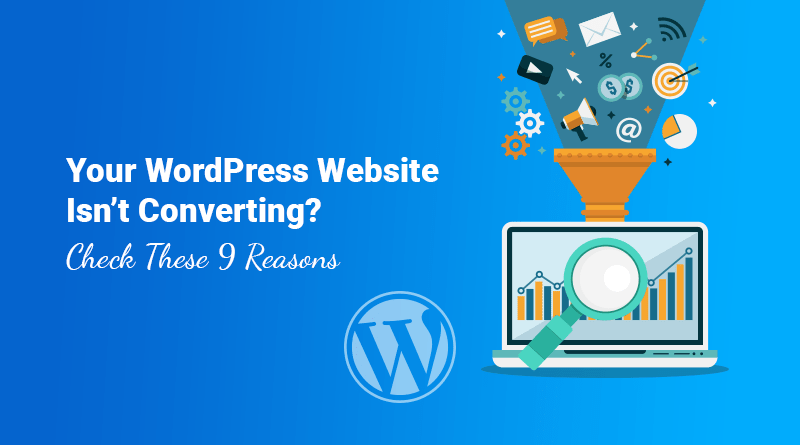Have you made your first WordPress website live. That’s your first achievement in the field of web development for which you spent a lot of time, resources and energy to learn as well as master the ultra-popular WordPress publishing platform. After a long time, you have now built the website of your dreams.
Do you think your website will start receiving traffic immediately? No, it won’t.
You can receive lot of traffic on your site, but that traffic doesn’t really matter if it isn’t getting converted into customers. Visitors that are adding to your bottom-line only play a significant role in growing your business. The rest of the traffic is essentially wasted.
Is your website receiving a lot of traffic or are you selling the right products at competitive prices? Yet not getting your visitors converted into customers. Then go through this article to find out why your site isn’t converting and what you can do about it.
Reasons for Why Your WordPress Site Isn’t Converting
 1. You Didn’t Do Your Keyword Homework
1. You Didn’t Do Your Keyword Homework
If there isn’t much traffic on your website then your conversion rate won’t at all matter. If your website is ranking somewhere after 50 search results then it won’t be found by the visitors. Whether your website will make it or break it, completely depends on identification and ranking for the right keywords.
Find out your potential customers requirements or what they are looking for online as it will help you to predict and target the changing market conditions. If you do a deep keyword research, you will be able to use specific keyword combinations that echo similar to the needs of customers that have made their buying decision. Instead of going for the generic keywords, dive deep into the details of your customers needs.
2. You’re Providing a Bad Mobile Experience
Is your website mobile friendly? If no then it won’t survive for long time. Just having a responsive website isn’t enough. Instead the content and structure of the website should be completely designed for mobile. If this isn’t the case then you are limiting your customer base, leading to decrease in your conversion rate.
So, how to design a mobile friendly website?
- Use large and easily readable text.
- Use short paragraphs.
- Ensure that every key feature is just a click away.
- Have just a single call-to-action.
Also, keep testing your mobile site. In fact, it is best to ask your customers and family members to give feedback on your site’s mobile experience. Later on, you should check what is working and what is not – and then work on those issues.
Until you don’t ignore the importance of having a good mobile experience for your site, you can easily improve and find the reasons for why your site is not converting.
 3. No Call to Action
3. No Call to Action
You might have a user-friendly website with quality and engaging content, but if there isn’t a clear and concise call-to-action, there won’t be any conversion. The visitors might think of purchasing a product from you but don’t get an option to do so, as you haven’t provided it.
See to it that your call-to-action is clear, short, popular, specific and persuasive. Your website should contain all the information that users require so that they follow the complete process till checkout. This is what you too expect from them. Calls-to-action play a vital role in getting conversions so, it is important that you place them in the notable areas of your site.
May it be anything you do, ensure that the users easily get converted when they are ready to.
4. Your Website Content Lacks the Depth and Quality
Content is the king. A high-conversion website comprises of a powerful language that showcases a passion for what you are doing. You page’s headline or display text should be such that it conveys a message about your company’s services and solutions which benefit customers over those who use other products.
So, make sure you include everything that a visitor requires or might search for. Think from the visitors’ point of view and then post the content on your site. Basically, write in-depth and customer-focused content that will help people to find it valuable to invest in your products or services.
Related: Tips On Writing SEO Friendly Content For SEO Beginners
 5. You’re Not Leading Your Users Through the Buyer’s Journey
5. You’re Not Leading Your Users Through the Buyer’s Journey
Are you not giving a reason for the visitors to buy your product? Don’t just convey that “This is my product/service and this is how you buy it”.
It sounds very straightforward to the visitor. You aren’t creating an interest within the visitors about your product through such messages.
In fact, you should help the buyers with the below queries:
- What is the product/service?
- Why should I buy your product/service?
- What if I am not interested to buy?
- Is there any video, infographic or ebook to get more information?
Obviously, not every visitor coming on your website will be ready to buy. Today’s buyers are very smart and one-step forward. They have complete information about your business at their fingertips. You need to keenly observe that what information they are finding and how you will solve their issue to avoid them from going to your competitor.
6. You Aren’t Targeting Right People
Is your website based on general topic? Then you aren’t on the right tract. There are so many such websites which aren’t based on a specific niche. Due to this, the website owners try to attract all types of audiences and then end up isolating their complete audience.
This won’t work at all.
It means you are either writing for the wrong audience or maybe you are writing for a large audience which you shouldn’t. Whatever it is, but if you target inaccurately then it will negatively impact your conversion rate. Your content, branding, marketing as well as website design should be such that it targets a niche audience.
Doing a proper market research, will surely help to find and know your audience.
Related: Guide to Reduce Bounce Rate on Your Website
 7. You Are Not Playing by Google’s Rules
7. You Are Not Playing by Google’s Rules
Google is the king of the internet today. If Chrome is your primary browser or you are accessing Google Search from Firefox or Safari, they are the search engines used for majority of internet searches.
Don’t miss to follow the below rules:
- Make your website mobile friendly.
- Update your content consistently.
- Check for broken links, 404 errors and images that require long time to load.
Websites that take efforts to remain updated and offer users with what they look for are rewarded by Google with high search ranking positions. It is a complete opposite case with other websites which don’t take any efforts. This surely brings traffic on your website but it isn’t possible to convert website visitors into customers or leads if there isn’t a single visitor on your website in the first place.
8. Your Website is Slow
When your website loads slowly, visitors won’t be staying on your website and there would very less possibilities of them visiting your website in future.
Below are some of the factors that can slow down your site:
- Website isn’t optimized for mobile.
- Broken links.
- Not using caching.
- Messy code.
- Images that aren’t optimized.
- Flash and Java usage.
- Average web hosting.
Your site speed can be tested using the Google Page Speed Insights tool. If your website requires more than 3 seconds to load, it is important that you work on it. As per the studies, users immediately exit sites that require more than 3 seconds to load.
 9. You Aren’t Measuring
9. You Aren’t Measuring
Don’t stop measuring. If you don’t measure, you won’t be able to guess and so, won’t take any steps to improve.
Most website owners don’t track their website traffic or maybe they do but don’t review their metrics. Some of them know that they track but just aren’t sure what to check and what to do about the results.
It is important to keep your goals in mind prior to starting. This helps you to identify the key metrics for measuring your progress towards those goals.
After you start measuring, you can make improvements based on those metrics. You can find out what is working and what isn’t and then build solutions and optimize them accordingly.
Wrapping It Up
It can be one of the reasons from the above due to which your WordPress website isn’t converting. There are many reasons for your site not getting converted. But these reasons are some of the common ones which an under-converting site faces.
If you think that any of these reasons match your business, just make the changes and see the big differences or improvement in your conversion rates and bottom line.







